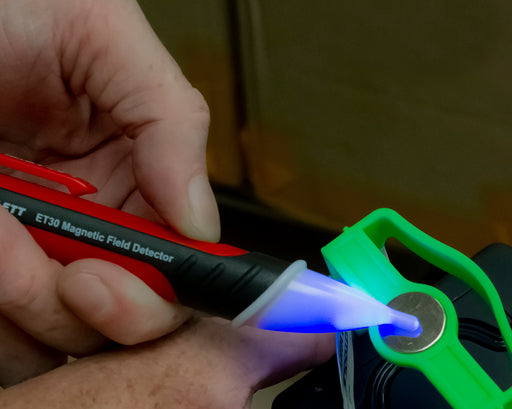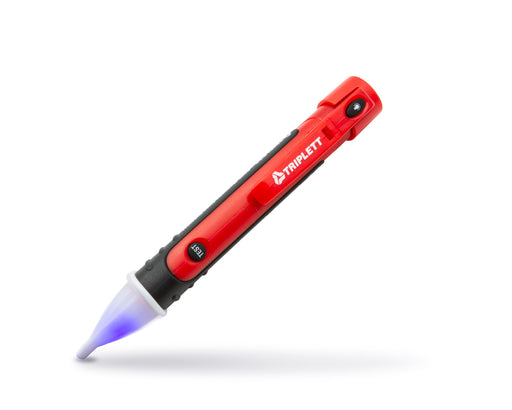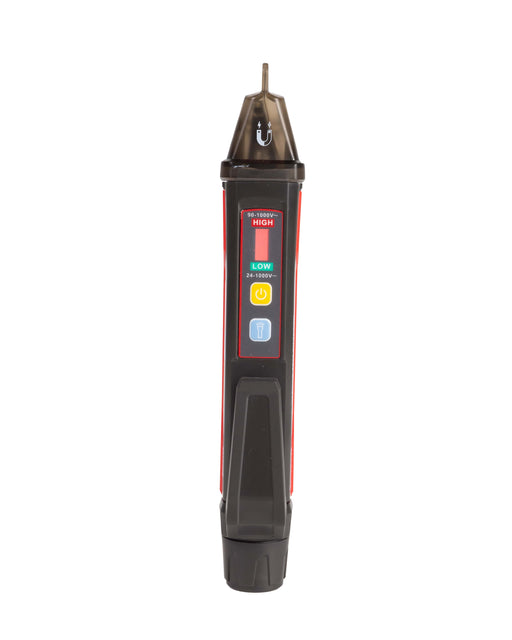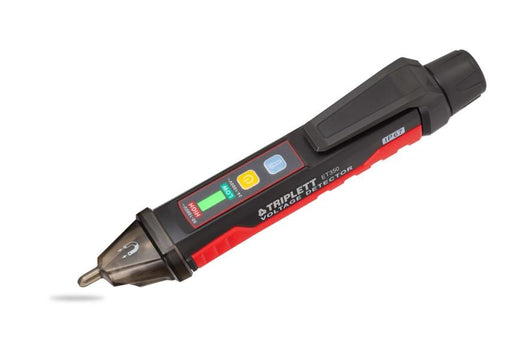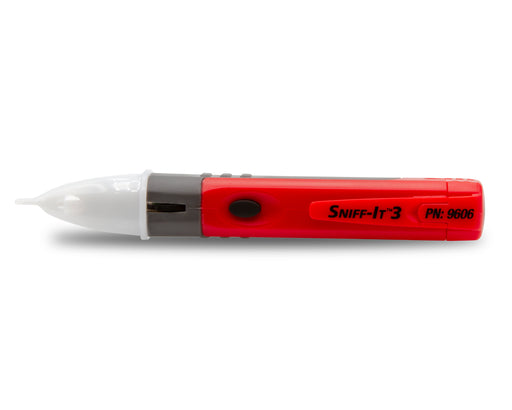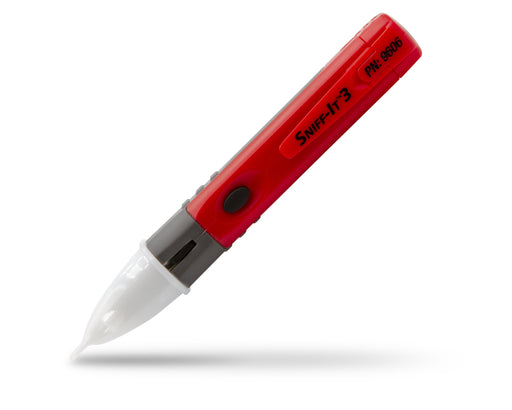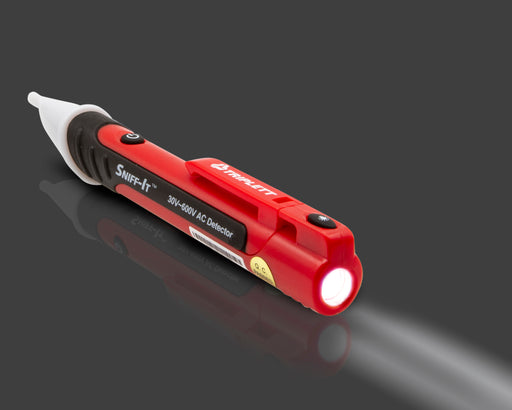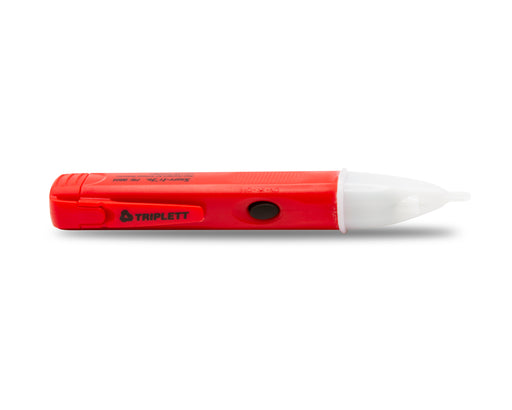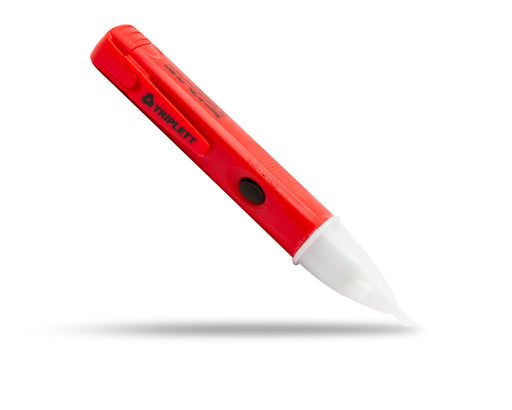
Non-Contact Voltage Detection Pen
Triplett offers a range of some of the best non-contact voltage tester pens for precise testing of AC voltage presence. Our high-performance non-contact voltage tester pens have adjustable sensitivity with a measurement range from 25 to 1000ACV and a dual-color tip to indicate high/low voltage range (red for high voltage range and green for low voltage range). The high sensitivity features allow it to detect low voltage AC wiring, mainly found in control circuits, thermostats, video surveillance systems, doorbell circuits, and so on. They also feature small, in-built LED flashlights for working around electrical work boxes. Our non-contact voltage tester pens are lightweight and convenient to carry everywhere due to their pocket size.
Non-contact voltage detector pens are designed to test the presence of AC voltage in electrical wires, cables, devices, or equipment without the need to make direct contact. These AC voltage detector pens, also known as a voltage tester or voltage sensors, are used by electricians, engineers, and technicians, to locate or troubleshoot faulty wiring or equipment on remote sites.
Filters
-
Original price $17.59 - Original price $17.59Original price$17.59$17.59 - $17.59Current price $17.59| /
Magnetic Field Detector: Quickly Determines the Presence of Magnetic Fields - (ET30)
Triplett Test Equipment & ToolsIn stockThe Triplett Model ET30 Magnetic Field Detector quickly determines the presence of a magnetic field including AC, DC and Permanent Magnets. Read M...
View full detailsOriginal price $17.59 - Original price $17.59Original price$17.59$17.59 - $17.59Current price $17.59| / -
Original price $28.59 - Original price $28.59Original price$28.59$28.59 - $28.59Current price $28.59| /
Non-Contact Voltage and Magnetic Field Detector: AC Voltage Ranges 24 to 1000V & 90 to 1000V - (ET350)
TriplettIn stockThe Triplett Model ET350 (for US use) combines a Non-Contact Voltage and a Magnetic Field Detector. Read More > DESCRIPTION The Triplett Model E...
View full detailsOriginal price $28.59 - Original price $28.59Original price$28.59$28.59 - $28.59Current price $28.59| / -
Original price $10.99 - Original price $10.99Original price$10.99$10.99 - $10.99Current price $10.99| /
Sniff It 3 Non Contact AC Voltage Detector - (9606)
TriplettIn stockTriplett Sniff-It 3 is a high-performance AC Voltage detector with adjustable sensitivity that has a wide measurement range of 25 to 1000ACV, Dual ...
View full detailsOriginal price $10.99 - Original price $10.99Original price$10.99$10.99 - $10.99Current price $10.99| / -
Original price $18.69 - Original price $18.69Original price$18.69$18.69 - $18.69Current price $18.69| /
Sniff It Non Contact AC Voltage Detector - (9602)
TriplettIn stockThe Triplett Sniff-It 2 is a high performance non-contact AC Voltage detector with adjustable sensitivity. It provides a wide measurement range of ...
View full detailsOriginal price $18.69 - Original price $18.69Original price$18.69$18.69 - $18.69Current price $18.69| / -
Original price $4.99 - Original price $4.99Original price$4.99$4.99 - $4.99Current price $4.99| /
Sniff It Jr Non Contact AC Voltage Detector - (9604)
TriplettOut of stockThe Triplett Sniff-It™ Jr is a Non Contact AC Voltage detector with a built-in flashlight. It detects AC voltage from 50 to 600V and has aubile an...
View full detailsOriginal price $4.99 - Original price $4.99Original price$4.99$4.99 - $4.99Current price $4.99| /Out of Stock -
Original price $54.99 - Original price $54.99Original price$54.99$54.99 - $54.99Current price $54.99| /
Non-Contact Optical Fiber & AC Voltage Detector - (ETFB10)
TriplettOut of stockThe Triplett ETFB10 combines a Non-Contact AC Voltage and a Optical Fiber Detector. It has a 50 to 1000V AC voltage range with high sensitivity tha...
View full detailsOriginal price $54.99 - Original price $54.99Original price$54.99$54.99 - $54.99Current price $54.99| /Out of Stock -
Original price $18.69Original price $18.69 - Original price $18.69Original price $18.69Current price $13.08$13.08 - $13.08Current price $13.08| /
OPEN BOX - Sniff It Non Contact AC Voltage Detector - (9602-OB)
TriplettLow stockThe Triplett Sniff-It 2 is a high performance non-contact AC Voltage detector with adjustable sensitivity. It provides a wide measurement range of ...
View full detailsOriginal price $18.69Original price $18.69 - Original price $18.69Original price $18.69Current price $13.08$13.08 - $13.08Current price $13.08| /Save 30% Save %
Know More About Triplett Non-Contact Voltage Detection Pens:
What Are Non-contact Voltage Detector Pens?
The voltage detector pens identify voltage presence in any electrical devices or equipment, with a buzzing sound and light at the tip of the tester. The device uses a battery to power devices and can detect electricity when it comes close in the range of electrical sockets, wires, live adapters, connection terminals, and more. The non-contact voltage detector pens are referred to as Electrical tester pen, electric detector pen, voltage detector pen, contactless voltage detector, and AC voltage detector pen.
Most of the voltage detector pens resemble a thick writing pen, while many have advanced features such as infrared (IR) thermometers and flashlights. The basic components of a non-contact voltage detector pen include a pocket clip, battery cap, IR thermometer sensor, laser pointer, LCD screen, voltage detection power button, IR thermometer power button, and flashlight. At Triplett, we design the best voltage detector pens with their drop resistance and impact in an ergonomic design. These voltage tester pens are CAT III rated and include AAA batteries. The easy-to-use thumbwheel helps in detecting accurate voltage range.
How Does A Non-Contact Voltage Detector Pen Work?
As the name implies, a contactless voltage detector pen works by detecting the electric field of the object conducting an alternating current (AC). The device detects the presence of voltage through capacitive coupling. A contactless voltage detector achieves this without making any direct contact with the conductor. The in-built sensor present at the tip of the tester glows, and the unit beeps when it senses voltage in a circuit. This mechanism is quite different from the electrical circuit traces or tone generators.
What Are the Differences Between Non-Contact Voltage Tester and Multimeter
Although both non-contact voltage testers and multimeters are generally used to detect the presence and magnitude of voltage, they differ from each other in terms of features and functions. Understanding the differences between the tool is crucial in determining which tool is best for your needs.
As the name indicates, a non-contact voltage tester is a handheld device that is specifically made to detect the presence of voltage without actually making direct contact with the electrical conductor. This adds to their convenience and safety when working with critical applications involving live circuits and electrical equipment. Non-contact voltage testers have a simple operating principle and they typically provide the result by detecting an electric field around the conductor. These testers also come with visual or auditory indicators that signal the presence of voltage. Our range of non-contact voltage testers is compact and are pen-shaped
In contrast to a basic voltage tester, a multimeter is an all-purpose tool that can be used for measuring various electrical parameters, including continuity, resistance, current and voltage. These tools typically include two leads that are attached to the circuit or component being measured. The measurement is displayed on the screen in digital values. Beyond this core capability, multimeters offer additional features such as capacitance measurement, diode testing and temperature sensing. Furthermore, these units may also have functions like data logging capability, auto-ranging feature and analog displays or bar graphs. These units are relatively bigger and shaped like a palmtop.
How Do I Use a Non-Contact Voltage Tester Pen?
Before proceeding to use any type of non-contact voltage detector pens, it is important to understand and follow the important instructions and warnings mentioned in the manual by the manufacturer. Here are some safety precautions when using a non-contact voltage tester pen.
- The first thing is to verify where to place the tip of the tester on a live wire or system. Next, for precise voltage readings, check the tester against a known voltage source to ensure batteries are fully operated or the voltage tester didn’t malfunction during the test.
- Do not put the lead into the wrong sockets; else it may lead to hazardous results, such as shorting of the circuit and much more.
- Ensure that the tester doesn’t touch anything other than live wires.
- Avoid using test leads if the protective insulations on the probes or leads are cracked or worn.
- Make sure you turn off the circuit immediately after testing.
Browse More Electrical Test & Measurement Collections
Multimeters & Clamp-On Meters:
Electrical Accessories:
| GFCI Receptacle Testers | AC Line Splitters |
| Electrical Hand Tools | Circuit Breaker Tracers |
Megohm & Resistance Testers:
| Megohmmeters - Insulation Testers | Earth Ground Resistance Testers |
Live Wire Circuit Testers:
| Live Wire Tone & Probe Kit |
Specialty:
| Power Supplies | Motor & Phase Rotation Testers |

